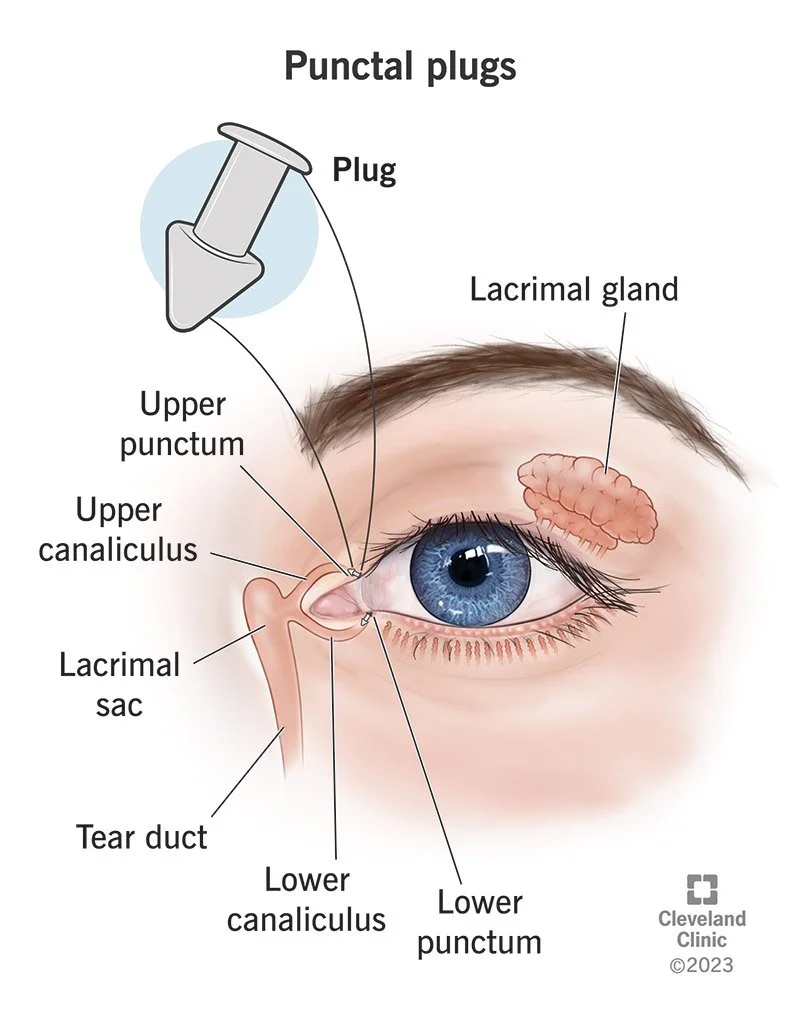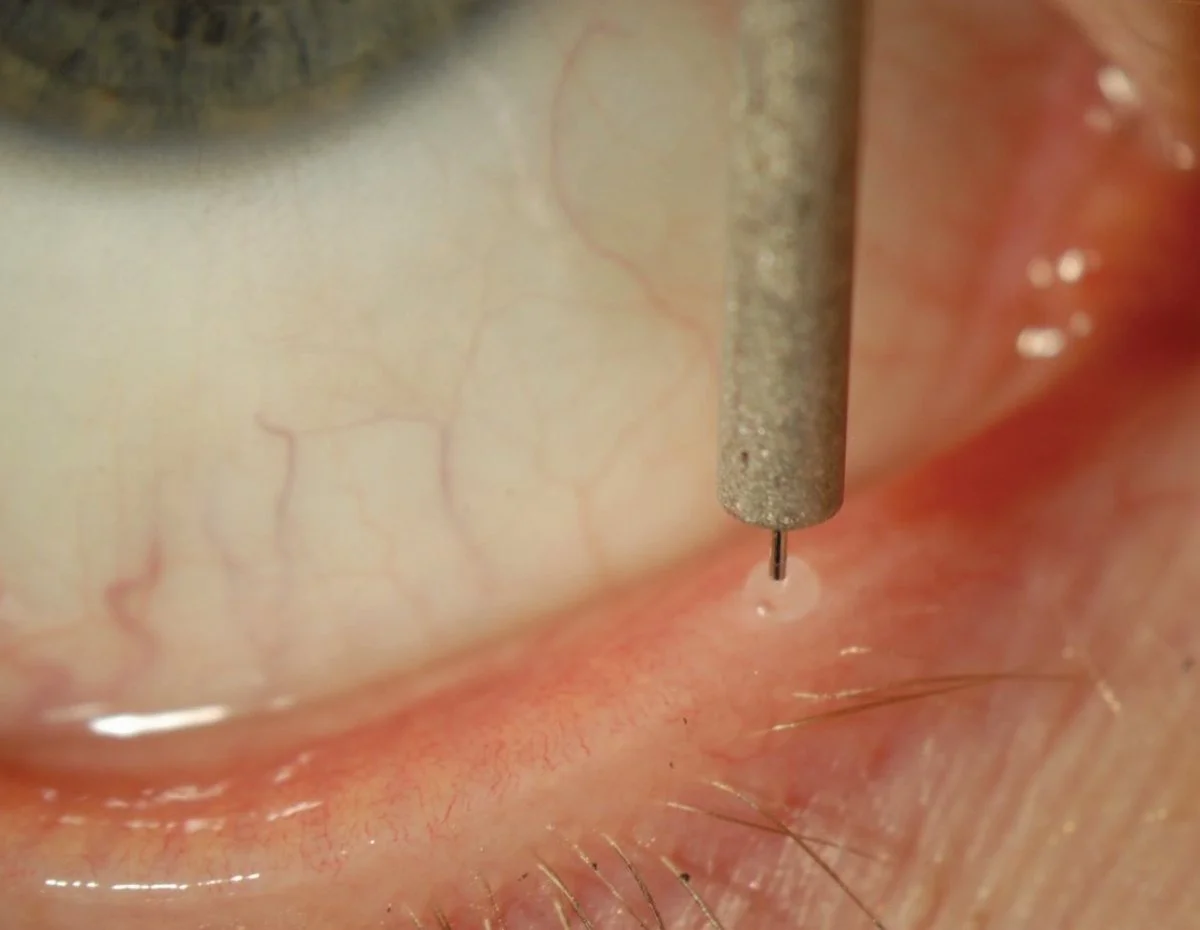Punctal Plugs for dry eye
Dry eye is a common condition that affects millions of people worldwide. It occurs when the eyes do not produce enough tears or when the tears evaporate too quickly, leading to inflammation and damage to the surface of the eye.
One treatment option that can be used alongside other modalities is punctal plugs (sometimes referred to as punctum plugs, or lacrimal plugs).
image from Cleveland Clinic.
What Are Punctal Plugs?
Punctal plugs are tiny, biocompatible devices inserted into the tear ducts (puncta) of the eyes. These ducts are responsible for draining tears from the surface of the eye into the nasal cavity. By blocking these ducts, punctal plugs help to retain tears on the eye's surface, keeping the eyes more moist.
There are two main types of punctal plugs:
Temporary Punctal Plugs: Made of materials such as collagen, these plugs dissolve over time, typically within a few days to months.
Permanent Plugs: Constructed from longer-lasting materials like silicone, these plugs are designed to stay in the eyes long term.
Silicone punctal plugs sit flush with the opening of the puncta are easily removed if needed. These are the most commonly used plugs.
‘Intracanalicular plugs’ are inserted deep into the drainage system. They are more secure, but can be difficult to remove in the event of an infection- for this reason clinicians don’t use these plug as often.
Image from https://www.reviewofoptometry.com/
When are they used?
Punctal plugs are useful in treating aqueous-deficient dry eye, where the eyes do not produce enough tears.
They are particularly useful in more severe dry eye conditions such as in ‘Sjogren’s syndrome’, where the tear producing glands don’t work well, patients with lid abnormalities such as Bell’s Palsy, and patients with persistant dry eye after surgery (such as LASIK).
Low tear production can be measured in office with a ‘Schirmer’s Test’.
How effective are punctal plugs for dry eye?
Punctal plugs does not work for all cases of dry eye - but it can work well on a subset of moderate to severe dry eye patients who are not able to produce enough tear volume- patient selection is key. For patients that respond well to punctal plugs, the results can be dramatic both in terms of patient comfort and the eye surface as seen under a microscope.
Benefits of Punctal Plugs
Punctal plugs offer several advantages for patients with dry eye:
Increased Tear Retention: By blocking the tear ducts, punctal plugs prevent tears from draining away too quickly. This helps to keep the eyes moist, alleviating symptoms such as dryness, irritation, and redness .
Reduced Dependence on Eye Drops: Many dry eye sufferers rely on frequent applications of artificial tears to keep their eyes comfortable. Punctal plugs can reduce the need for these drops.
Minimally Invasive: The insertion of punctal plugs is a quick, in-office procedure that typically requires no anesthesia.
Risks and Potential Complications
While punctal plugs are generally safe and effective, there are some risks and potential complications to be aware of:
Discomfort or Irritation: Some patients may experience a sensation of the plug being in place- this is usually temporary, but for some patients with very sensitive eyes the sensation can persist.
Infection: As with any procedure involving the eye, there is a risk of infection. Proper hygiene and following the care instructions provided by your eye care provider can help minimize this risk, and topical antibiotics may be required to treat an active infection.
Plug Displacement or Loss: Punctal plugs can sometimes become dislodged or fall out, especially if there is eye rubbing.
Watery eyes: This is usually temporary and settles down within the first couple of weeks.
Granuloma Formation: Rarely, the body may react to the presence of the punctal plug by forming a small, inflammatory nodule called a granuloma. This may require the removal of the plug and treatment of the inflammation
Weighing the Risks Against the Complications of Severe Dry Eye
While these risks are important to consider, they must be weighed against the potential complications of untreated or severe dry eye syndrome. Chronic dry eye can lead to significant issues, such as:
Corneal Damage: Persistent dryness can cause damage to the corneal surface, leading to abrasions, ulcers, or even scarring, which can permanently impair vision
Increased Risk of Eye Infections: A lack of adequate tear production or retention can compromise the eye's natural defense mechanisms, making it more susceptible to infections like conjunctivitis and keratitis
Decreased Quality of Life: Severe dry eye can significantly affect daily activities, causing discomfort, visual disturbances, and even depression or anxiety due to chronic pain and irritation .
Final Comments
Punctal plugs are a valuable tool in the management of moderate to severe dry eye. They are not the first line of treatment for dry eye, but in a small subset of dry eye patients- they can lead to a tremendous improvement to a patient’s dry eye condition.
In our clinic, we use often punctal plugs in combination with at home treatments, prescription medications, and in-office treatments such as meibomian gland expression and IPL.
Author Bio
Jenny Wu is an optometrist based in Canberra, Australia. She is a full scope optometrist specializing in dry eye, specialty contact lenses, myopia control, and orthok. She practices at Simpson Optometry. In her spare time she enjoys spending time in nature, photography, gardening, and being with her husband (also an optometrist) and 2 children.

